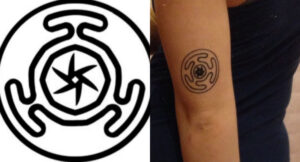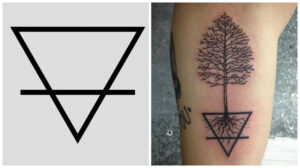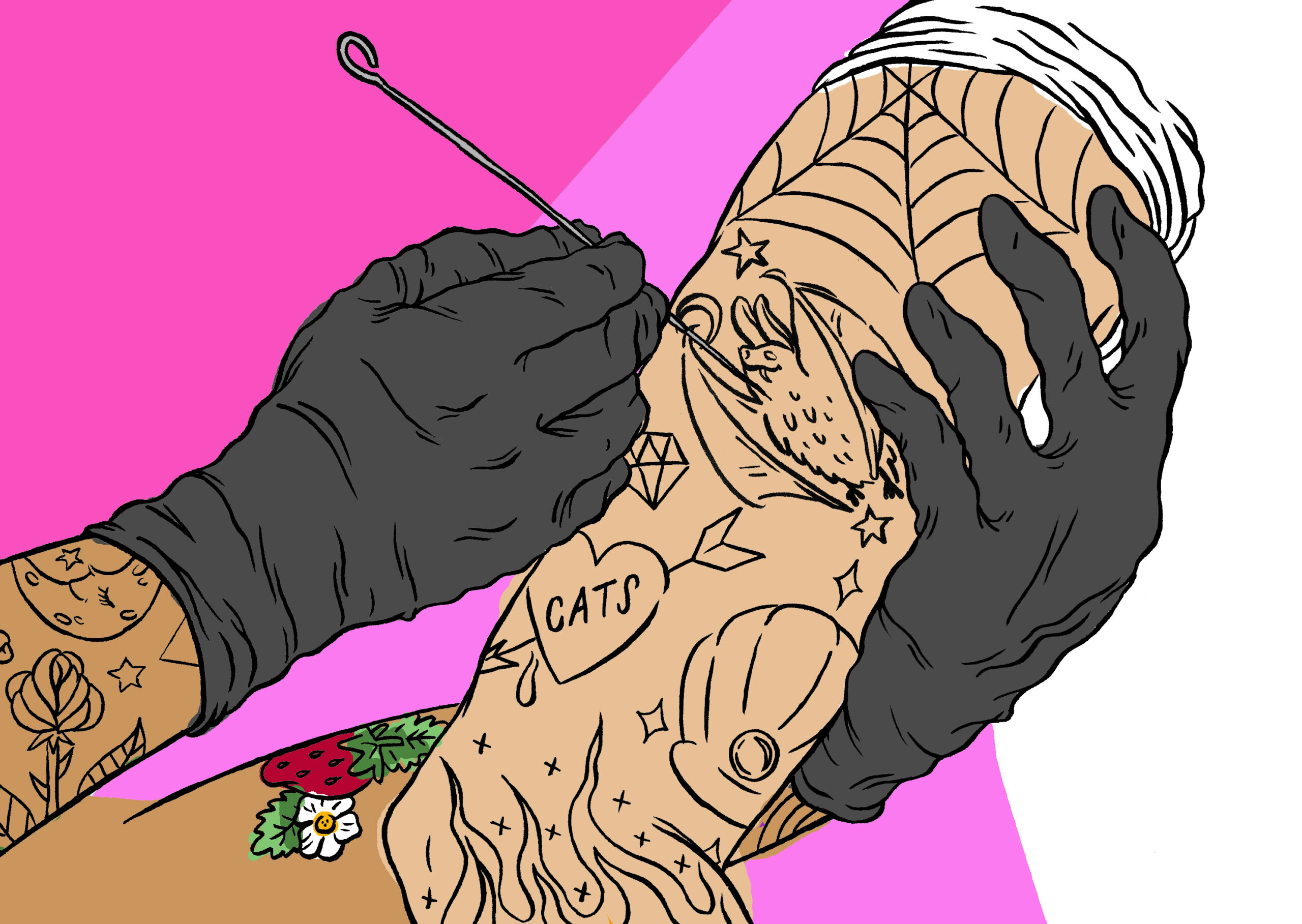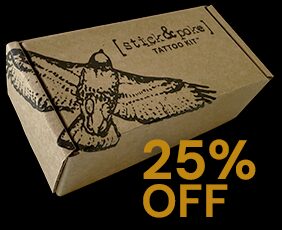Unalome and other traditional tattoos are growing in popularity as globalization, e-commerce, low airline fares and widespread digital social communication all contribute to the continuous swirling of people and goods from one end of the globe to the other. What a time to be alive! It really is exciting! If you are of European descent, you may be asking yourself: "Now that I've been to several Wats in Thailand,‑
...should I get an unalome tattoo?"
My advice is: Definitely, No! Read why below....
Traditional cultural symbols, like the Unalome or Om are from Buddhist and Hindu religions, respectively.
Om (Auṃ or Oṃ, Devanagari: ॐ) is the most important symbol in Hinduism (India). We are talking about a 3500 old culture and this symbol is the most sacred symbol for billions of people. Frivolous wearing of the symbol or printing it all over is considered by some, very disrespectful. Buddha and Lotus (or Padma) tattoos from Buddhism are gaining popularity with the world's new yogis. This has created some controversy with white travelers(BBC news) sporting symbols and imagery that offends.
Because these civilizations existed before electricity (and little motors), we know that they were done using the manual "hand poke" technique. In recent times, this is branded as"stick and poke tattoo" or "stick n poke tattoo." You can read about that more here- "What is stick and poke?" Generally speaking, hand poked tattooing is a slow, painful method that allows a ritual and rite of passage as part of the process. In some traditions, additives (like Tumeric in India) are added to the soot, which is used as ink. This is as old as human history, and in tattoo cultures, deep legend and ceremony surrounds the practice.
Irezumi and Tebori Tattoos from Japan are also in the category of traditional tattoos. Culturally, they carry significant meaning. Mulu and Pe'a tattoos derive from ancient Samoan culture. In New Zealand, the Māori people have practiced traditional Ta Moko tattoos for thousands of years. Many of India's hundreds of distinct tribes have a rich history of tattooing with intricate meaning; a practice continues today.
What beautiful tattoos these can be - especially when they have rich meaning for the wearer and surrounding community that goes back generations and honors close ancestry and culture.
The Unalome represents the crown of the Arahants (Enlightened Saints), the spiral stands for the crown at the center of the scalp, and the straight line pointing upwards, representing the straight path to Enlightenment without any wavering behavior, that the Arahants have accomplished. I likely cannot understand the significance and the power of these tattoos. As a white person with Irish, Welsh and Swedish roots, it is not in my blood nor roots. The meaning can never be as great for me as it is for people belonging to the culture and religion.
For some, tattoos can represent a very deep devotion, love and understanding of one's linage, self and tribe/community.
Today, professional machine tattoo artists can have someone in and out in an hour - sporting whatever someone points to in a book - a symbol or character or whatever they are feeling strongly after a couple of Singha Beers or going to a gorgeous awe-inspiring, golden Wat. As those of us interested in tattoos decide what we want on our bodies for the next 30-80 years, might we have some reflection on how our tattoos would be received from the perspective of people in the culture that it comes from? How might they react to this new tattoo? I am proposing they may feel offense, shame and at the very least, confusion.
As white people, we can hopefully come to understand how getting a traditional tattoo is culturally appropriative and can cause suffering for people in that culture as this practice can be a form of colonialism
Those of us with European roots (me included) have encountered a modern horn of plenty stretched before us - a beautiful diverse banquet of ripe, off season fruits for the taking - worldly fare from across the planet - racks of cloths and fabrics from wardrobes around the globe for us for only $9.99! Spices and stones and gems and coconut water all made with pleasing colors, aromas and materials. What ecstasy is being alive now, here in "developed" nations on this glowing blue ball.
Nature’s diminishing bounty is ours for the taking, with endless choice in color, size, material, any fusion of flavors. Appropriation has become a lucrative business for some in the west. Recognizing the origin of these goods – and the people and cultures that they derive is one step in a vital process to understand the impact of their consumption. The same may apply to the using of cultural symbols for use as tattoos.
The story of the Buddha's journey to enlightenment takes place 2600 years ago, Siddhārtha, royalty in Nepal/India region, was given whatever he wanted including, access to women's bodies, booze, a "prized" wife and family, horses - all his desires are met and exceeded. But when he sees at suffering outside his kingdom, he becomes invested in understanding the human condition. He leaves his life of luxury to seek the end of human suffering. For six years he tried different practices - including starvation and renouncement of all pleasures. Eventually, after sitting under a Lotus tree, he becomes enlightened. This is an impactful story that is the basis of a religion with over 376 million followers and integrated inseparably into the fabric of many cultures in the east.
A Sak Yant tattoo gives tribute to the Buddha's journey. Sak means "to tap" and "Yant" is a Sacred geometry design incorporating Buddhist psalms and magical formulas that invoke various elements and powers of protection and various blessings.
While we are in the Corporate United States, or Europe - enjoying ripe mangos in winter, our legacy of destruction continues. Our not-too distant relatives started to wreak havoc on the globe and Mother Nature and her brown and black inhabitants. Our world economic model is built on the exploitation of other people and places. The nightmare, for some, continues to this day - since Columbus, Queen Victoria, the slave ships, Manifest Destiny and the rest of the unthinkable "reasons" why European explorers and then colonizers felt entitled to everything before them. Today we too can look "outside the kingdom" and see the connection between what’s happening today and historical events involving our forefathers.
We can make a choice with our one privileged life. We can please choose not to steal & profit off another culture. And - for something seemingly so small as choosing a tattoo we can, as white people, also choose not to continue the erasure, dilution, and appropriation of ancient traditions and religions. We can notice the entitlement that comes with our culture and we can choose another route.
Consider the meaning of your tattoo
Which has more meaning for the wearer? A symbol one has appropriated or a symbol that is near and dear to one's life, and family (chosen or blood relatives).
What is YOUR sacred symbol? What thing - if someone else got tattooed who didn't understand like you understand - would enrage you? A locket your grandmother gave you? Or is it the Dave Matthews dancing woman? (ha ha)
On the Om tattoo: If you already got one, OK. You were young, naive. Caught in the moment and possibility of having the 'sound of the universe' on your wrist or nape of neck. I get it. It really is an amazing symbol with intoxicating, universal meaning to anyone who encounters it. I almost got one, myself! I actually had an 'Om' as a good tattoo idea in my kit photo gallery until someone alerted me to the implications. My best friend had a spiritual awakening in *his 20's in Thailand and he is tatted up with all the symbols of the culture. It is OK - we are learning. Forgive your wild wandering self that was unaware of the intricacies of oppression. Maybe get a cover up? Either way, we can recognize what happened.
To honor your own ancestors, to feel something of your roots may you consider the symbolism, heroines and heroes of your own lineage for your next body art.
European decedents are related to a female ancestry that challenged the oppressive powers and the church (then branded "witches,") who died by torture and brutal burning at the stake. Many non-white cultures have these amazing stories of struggle, lore and magic as well. We can learn about and adorn ourselves with symbols that tribute and imagery to these bad-ass witches and to the Divine Feminine (that has been oppressed for hundreds of years by a brutal patriarchy that has devastated long, far and wide).
European legends are filled with symbols, lore and universal appeal that parallel those of the Om and Unalome symbol
Wiccan and pagan symbols have great meaning to proud euro roots - and have been all but erased by Christianity. Let's bring em back. There is the Claddagh from Irish tradition and the Germanic celtic cross. Norse seafarer tattoos have great symbolism for those with Scandinavian heritage. Here is a resource for the aspiring Wiccan. What is a badge of divinity, strength and spirituality for you and yours? What do you want to lift up or connect to?

Dragons, Unicorns, black dogs, Hecate’s wheel, triple spirals, serpents, bats, fires, and six-pointed stars are all actually really cool. After reading about these simple symbols, I feel inspired to get one on my body. These come from a very deep, grounded place of my own people’s serpentine past. Through this tattoo, I will feel the ache and power of witches and queers that came before me in my bloodline. Their struggle and strength are inside me somewhere.

Of course, there are beautiful designs to pull directly from nature. As animal earth dwellers, I feel those belong to all of us in the most intimate way.
When you go to the shop, or sit down with this kit, ask yourself - "what is the meaning of this image that will adorn my body?" In the words of Mary Oliver, "Tell me, what is it you plan to do with your one wild and precious life?" - NW
NW. is part of the SnP team. Main Illustration by Raisa Yavneh (IG: @dumptruck.jpg)


